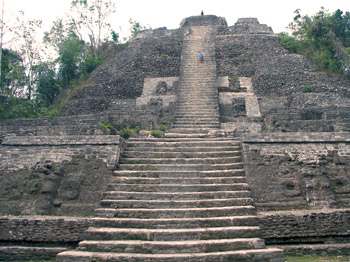
Lamanai, Belize
by Troy Herrick
Get ready for your own “Indiana Jones-type” of adventure with a visit to the Mayan city of Lamanai whose name translates as “Submerged Crocodile”. Not only is a visit to this archeological site worthwhile but the journey there is as much of an adventure as the destination itself. This city is so far off-the-beaten-track in Northern Belize that the Maya actually inhabited the site well into the 19th century with minimal European incursion. Unlike many other Mayan cities which were abandoned in the 9th Century CE, Lamanai was continuously occupied for almost 33 centuries because of its reliable water supply. The city was only abandoned after a series of epidemics depleted the local population.
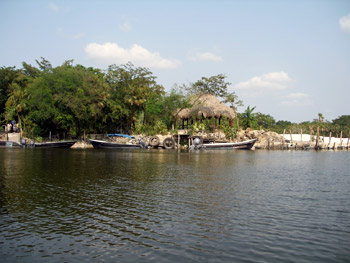 Your journey into the unknown begins in “touristy” San Pedro on Ambergris Caye when you travel by boat (skiff) to the village on Bomba on the Old River. Your skiff brings you into the red mangroves where the river meets the sea. The captain effortlessly races through the narrow bends in the river. Perspiration drips off your face but not from fear. It is the humidity from the nearby jungle. Suddenly he cuts the throttle and you glide to a halt on top of the turquoise water so that he can point out the local flora and fauna. Snake Cactus parasitically grows on the trees; gray bats hang from the underside of a long dead tree trunk; and a big gray blob is actually a termite nest.
Your journey into the unknown begins in “touristy” San Pedro on Ambergris Caye when you travel by boat (skiff) to the village on Bomba on the Old River. Your skiff brings you into the red mangroves where the river meets the sea. The captain effortlessly races through the narrow bends in the river. Perspiration drips off your face but not from fear. It is the humidity from the nearby jungle. Suddenly he cuts the throttle and you glide to a halt on top of the turquoise water so that he can point out the local flora and fauna. Snake Cactus parasitically grows on the trees; gray bats hang from the underside of a long dead tree trunk; and a big gray blob is actually a termite nest.
Approximately an hour after departure, you arrive at the Creole village of Bomba where you can catch your breath for a few minutes and seek out that perfect handcrafted souvenir before your bus whisks you to away on the next leg of your journey to the village of Shipyard on the New River. Your bumpy route snakes along what was once the old Pan American Highway in the 1950s; it has since been re-routed.
 Arriving at Shipyard, you again board a skiff and race along the New River to Lamanai. This time the captain stops the boat to point out several Spider Monkeys swinging through the trees. They streak so quickly through the foliage that you might have difficulty making out these dark brown figures with their characteristic white chests. Further down the river you might come across a “herd” of young Mennonites fishing at the water’s edge. They compete for the fish with several Great Blue Herons situated a short distance away. You may also spy the black and brown Jacana bird effortlessly moving across the green sheet of lily pads extending out from the river’s edge. Also known as the “Jesus Christ bird”, it seemingly walks on water.
Arriving at Shipyard, you again board a skiff and race along the New River to Lamanai. This time the captain stops the boat to point out several Spider Monkeys swinging through the trees. They streak so quickly through the foliage that you might have difficulty making out these dark brown figures with their characteristic white chests. Further down the river you might come across a “herd” of young Mennonites fishing at the water’s edge. They compete for the fish with several Great Blue Herons situated a short distance away. You may also spy the black and brown Jacana bird effortlessly moving across the green sheet of lily pads extending out from the river’s edge. Also known as the “Jesus Christ bird”, it seemingly walks on water.
What we did not see along the way was a crocodile, although Diane and the captain did hear a sudden splash which indicated that we were being studied by one. We kept our arms inside the boat just in case as we did not want to become some crocodile’s lunch.
After the 26 mile journey from Bomba, your skiff effortlessly glides into the docks at the edge of the New River Lagoon where a thick forest canopy and ground cover hides the remnants of over 700 buildings from view. Less than 5% of these structures have been excavated to date.
What is your first order of business upon landing? You renew your strength over lunch before embarking on your march through the jungle; your tour includes a delicious meal of red beans and rice, fried chicken, cole slaw, fried plantain, potato salad with a beer or soft drink chaser. After eating, you meet your tour guide and begin your archeological adventure.
 You trek through the steamy jungle toward the Jaguar Temple which dates to 625 CE. Suddenly the thick mass of foliage opens out and you find yourself staring into the eyes a block-like jaguar face protruding from the side of the temple. You may require a few moments to get the gestalt outline of this mask. This step pyramid has nine tiers and rises to 65 feet in height. But looks are deceiving in that part of this temple remains covered by soil and foliage so you cannot appreciate its true height. This temple is a solid structure with no chambers or tunnels inside.
You trek through the steamy jungle toward the Jaguar Temple which dates to 625 CE. Suddenly the thick mass of foliage opens out and you find yourself staring into the eyes a block-like jaguar face protruding from the side of the temple. You may require a few moments to get the gestalt outline of this mask. This step pyramid has nine tiers and rises to 65 feet in height. But looks are deceiving in that part of this temple remains covered by soil and foliage so you cannot appreciate its true height. This temple is a solid structure with no chambers or tunnels inside.
The Jaguar Temple dominates a neighborhood of residential buildings known as the Royal Complex. A typical home for the Mayan upper class is a narrow room with tall thick walls covered by a thatched roof. This room also features a flat limestone plastered bed and a door that opens out into a central plaza.
After seeing what appears to be more like jail cell dimensions, you may be surprised to find out that the elite class was approximately 5 feet 7 inches tall while the lower class, which lived outside the Royal Complex, was approximately 4 feet 2 inches tall. The skeletons of the latter had developed bending fractures over time because of transporting stones from a quarry that is over a mile away to the building site. They transferred these blocks using bands that were tied around their forehead. The bending fractures appeared to be genetic because their babies were born with them as well.
The king, who was worshipped as a living god, controlled the religious and political activities within the city. The deeds of these Mayan kings were often recorded on limestone stelae. Stela 9 in Lamanai, erected in 625 CE, commemorates King Smoking Shell whose image is dressed in a rattlesnake headdress with quetzal feathers at the back; he holds a double-headed serpent bar diagonally across his body. An inscription on the stela indicates that this king was descended from the Sacred Crocodile.
 Only royalty and members of the elite class were permitted to climb to the summit of a temple. When you arrive at the High Temple, dating to 100 BCE, you can follow in their footsteps up the side of this steep structure to speak with the gods. Even though you take carefully calculated steps, your legs will still feel like lead weights by the time you reach the top of this temple as each individual stair is an uncomfortable two feet high. Other Mayan cities like Chichen Itza, Copan and Tikal for example have significantly lower individual steps but steeper stairways up the side of their pyramids, which only goes to prove that there is no standard Mayan temple design. In any event, if you weren’t drenched in perspiration before you begin your ascent, you will be by the time you reach the top. Bring a bottle of water when you climb in order to clear your parched throat because you are going to need it.
Only royalty and members of the elite class were permitted to climb to the summit of a temple. When you arrive at the High Temple, dating to 100 BCE, you can follow in their footsteps up the side of this steep structure to speak with the gods. Even though you take carefully calculated steps, your legs will still feel like lead weights by the time you reach the top of this temple as each individual stair is an uncomfortable two feet high. Other Mayan cities like Chichen Itza, Copan and Tikal for example have significantly lower individual steps but steeper stairways up the side of their pyramids, which only goes to prove that there is no standard Mayan temple design. In any event, if you weren’t drenched in perspiration before you begin your ascent, you will be by the time you reach the top. Bring a bottle of water when you climb in order to clear your parched throat because you are going to need it.
At the summit of the High Temple, you have a beautiful panoramic view of the nearby river over the jungle canopy from a height of 112 feet. You might also catch a glimpse of your next destination – the ball court – where the Mayan national past time of Pok-Ta-Pok is played. Given the number of Mayan cities in Central America, it is not known if there was a Pok-Ta-Pok league similar to our modern baseball, football and basketball leagues; but if there was, the teams would have been depleted over time because the losing team was ritually sacrificed after the game. One additional complication was that each city had its own rules for how the game was played, so the home team likely would have always had the advantage.
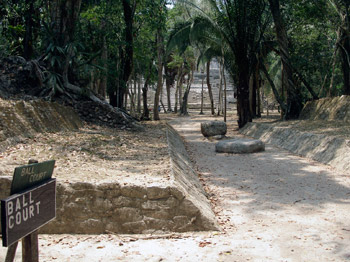 Work your way down the tall steps of the High Temple and refresh yourself with some more water when you reach the bottom before marching on to one of the smallest ball courts in the Mayan world. You might have some difficulty determining what the target was that the players were aiming to hit with the 12 lb solid rubber ball in order to score. Ball courts in other Mayan cities have utilized rings or even stone parrot heads. Players were only allowed to keep the ball in play with their hips, knees, waist and elbows.
Work your way down the tall steps of the High Temple and refresh yourself with some more water when you reach the bottom before marching on to one of the smallest ball courts in the Mayan world. You might have some difficulty determining what the target was that the players were aiming to hit with the 12 lb solid rubber ball in order to score. Ball courts in other Mayan cities have utilized rings or even stone parrot heads. Players were only allowed to keep the ball in play with their hips, knees, waist and elbows.
Imagine that your tour group is the winning team and clamour through the ball court to your final destination known as the Mask Temple. The Mask Temple is named for the two 13 foot high carved limestone masks straddling the first level. Both masks are identical and feature the same upturned lip and broad nose. Each is decorated with a crocodile-mouth headdress. You will know that you are dehydrated if you find that these two faces are speaking to you.
Set deep within the Mask Temple are two tombs dating to the 6th century CE. The first held a man whose remains were adorned with shell and jade jewelry. The second tomb housed a woman who was not described in any detail. It is not known how they were related – possibly a king and queen. I was unable to find any reference that outlines the height of this temple but I estimate that it is about 57 feet tall.

Exiting the museum, your guide herds you back into your skiff for the return trip down river to Bomba. Again watch out for submerged crocodiles and remember to keep your arms inside the boat.
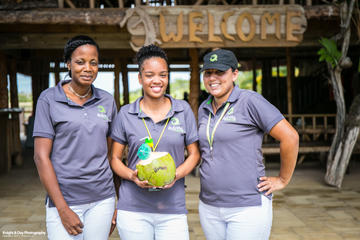
Lamanai Maya Temple and Baboon Encounter from Belize City – PRIVATE
If You Go:
Tours to Lamanai can be arranged through your hotel/resort in San Pedro. You can also arrange a tour leaving from Belize City as well. You are permitted to climb all the temples at Lamanai.
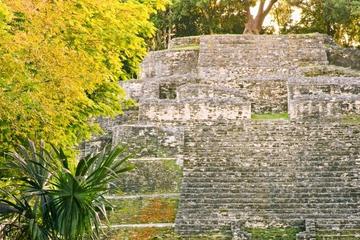
Belize New River Cruise and Lamanai Maya Ruins Day Trip by Air from Ambergris Caye
About the author:
Troy Herrick, a freelance travel writer, has traveled extensively in North America, the Caribbean, Europe and parts of South America. His articles have appeared in Live Life Travel, International Living, Offbeat Travel and Travel Thru History Magazines.
Photo credits:
All photos are by Diane Gagnon, a freelance photographer who has traveled extensively in North America, the Caribbean, Europe and parts of South America. Her photographs have accompanied Troy Herrick’s articles in Live Life Travel, Offbeat Travel and Travel Thru History Magazines.



[…] masks featuring upside-down crocodile snouts during excavations that give this ruin city its name: Submerged Crocodile City. Furthermore, visiting this archeological site allows you to see El Castillo which is […]